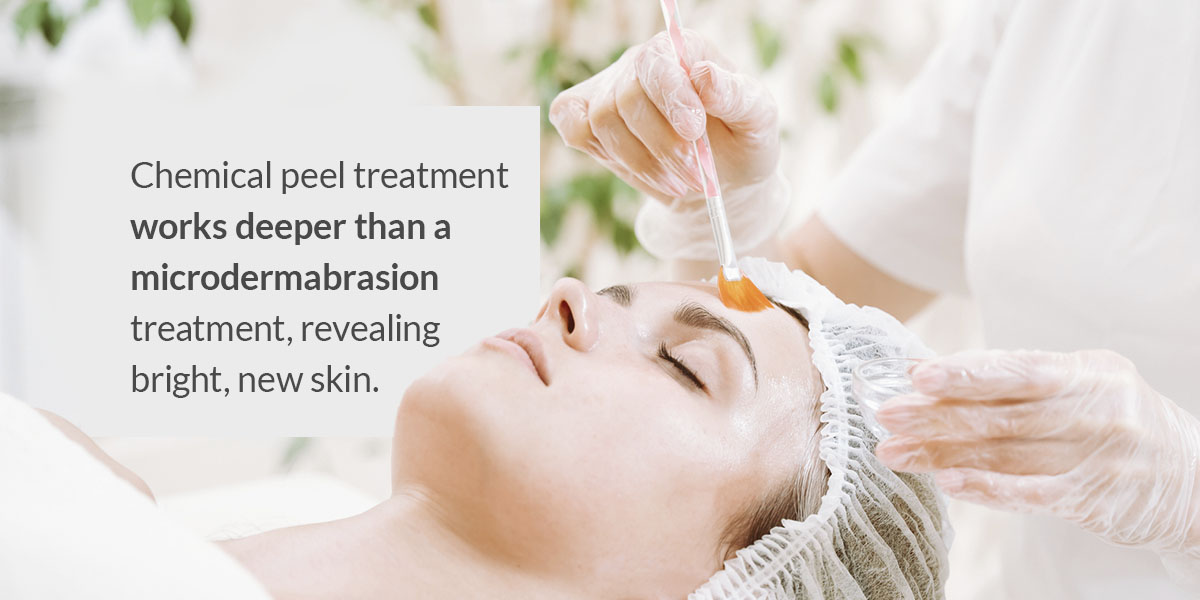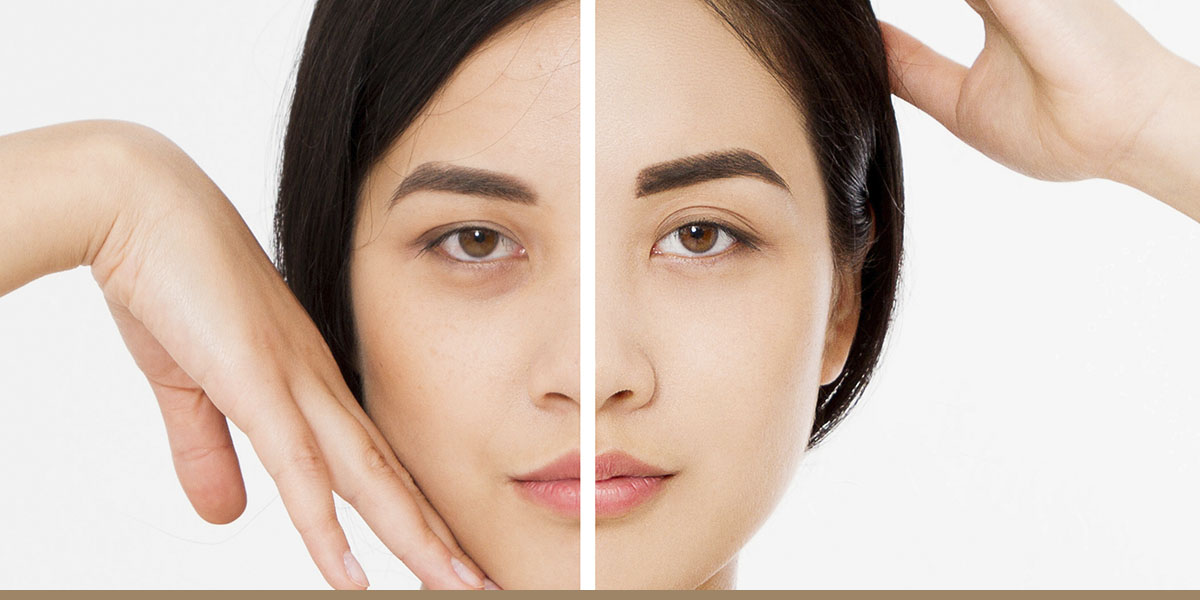Chemical peels and microdermabrasion are two very popular skin treatments. Both can address several skin concerns and create a more even, glowing appearance. Understanding the differences between these two procedures is vital to choosing the right solution for your skin. Keep reading to learn about these treatments and when they’re helpful.
Once you’ve determined the right procedure for you, schedule an appointment with Berman Skin Institute.
What Is a Chemical Peel vs. Microdermabrasion?
Although chemical peels and microdermabrasion can address some of the same conditions, there are many differences in how they work, the ingredients they use and the results you can expect. Both are exfoliants, but one provides a deeper treatment and can treat more severe skin concerns.
What Is Microdermabrasion and When to Get One
Microdermabrasion is a physical exfoliation treatment. It is noninvasive and removes dead skin from the outer layer of your skin. Microdermabrasion can address dry skin, acne, minor scars, clogged pores, fine lines, Rosacea and uneven pigmentation. This procedure is ideal for treating blackheads and whiteheads and has a short healing time.
There are three types of microdermabrasion treatments:
- Diamond tip microdermabrasion: With a diamond tip microdermabrasion treatment, a diamond-tipped wand will exfoliate your skin to get rid of dead skin cells.
- Crystal microdermabrasion: During this treatment, a small tube will squeeze microfine crystals onto your skin. You will experience a gentle rub for exfoliation.
- Hydradermabrasion: This process involves a combination of dermal infusion and crystal spray. You will undergo a cleanse to remove dead skin cells and receive a hydrating treatment to nourish your skin. Lastly, a protective step helps maximize your glow.
Some people confuse microdermabrasion and microneedling. Microneedling requires needles and goes deeper into the skin than microdermabrasion. Microdermabrasion rejuvenates your skin and helps reduce some skin concerns. The process often takes between 30 and 45 minutes for the face and about 20 minutes for the neck. Patients can often return to regular activities on the same day as the procedure.
Microdermabrasion only removes the top layer of skin and should not cause pain with the proper techniques. Some patients may experience mild side effects such as swollen skin, a stinging sensation or sun sensitivity. After the procedure, you can expect a smoother skin tone, a glowing appearance, less acne and an even skin tone.
What Is a Chemical Peel and When to Get One

Chemical peel treatments are excellent for brightening your face, exfoliating dead skin and evening out your skin tone. Chemical peels are chemical exfoliants and can treat conditions like scars, acne, blemishes, wrinkles, sagging skin, hyperpigmentation, brown spots and crow’s feet. This treatment works deeper than a microdermabrasion treatment, revealing bright, new skin. There are also three types of chemical peel treatments:
- Superficial or light peel: Dermatologists can use mild acids for these peels to treat lower-level skin discoloration.
- Medium peel: Medium peels can treat conditions like fine lines, dark spots, wrinkles and age spots.
- Deep peel: If you need to treat more severe concerns, like darker age spots or deep scars, you can opt for a deep peel.
These treatments treat more serious skin issues, and they involve a longer process. Often, the process begins with the dermatologist cleaning your face. You may receive goggles to protect your eyes. You may also receive topical anesthesia to numb the area before starting. Then, you will receive the chemical formulation. This treatment includes glycolic acid, which can stimulate new collagen growth and dissolve the natural glue holding dead skin cells together.
Your treatment can vary in time depending on the chemical peel you choose. Light peels may not take long, while medium or deep peels could take between 30 and 90 minutes to finish. This treatment aids more serious skin conditions, and a slight tingling sensation is common during the procedure. Chemical peels often do not require downtime. However, depending on the strength of the acid, you may experience some downtime after the procedure.
You will need to prepare for the treatment two to three days in advance. During this time, you will need to avoid excessive sun exposure. After the treatment, you must also avoid retinoid acid creams and excessive sun exposure for two to three days. Although results may vary, you can expect a smooth skin tone, less discoloration, fewer lines, reduced acne and an even, glowing appearance.
Considerations for Deciding Which Treatment to Get
Although chemical peels and microdermabrasion can address similar concerns, you must consider several factors before deciding which treatment is right for you. For instance, if you’re considering a microdermabrasion or chemical peel for acne scars, you may want to opt for a chemical peel to address those deeper issues. However, you may opt for a microdermabrasion treatment to treat surface acne. Consider these factors before scheduling your appointment:
- Skin type: Evaluate your skin type before choosing a treatment. Chemical peels and microdermabrasion are suitable for most skin types, but you should establish which exact treatment is best for your skin type. For example, people with sensitive skin should opt for a mild chemical peel rather than a deep chemical peel. Additionally, you should consider the ingredients of both treatments to avoid coming in contact with a potential allergen.
- Skin concerns: Chemical peels address deeper skin concerns. If you want to address darker age spots or acne scars, you will find more success from a chemical peel than a microdermabrasion treatment. Determine what you most want to address to decide which treatment is best for your skin.
- Desired results: Both treatments offer similar results, but chemical peels can give your skin an additional boost. Both procedures often result in more even and glowing skin, but chemical peels can also reduce discoloration and lines. You can also request a microdermabrasion and chemical peel together for exceptional results.
- Cost or treatment times: A chemical peel is the way to go if you’re looking for a long-lasting result. However, these treatments can be more expensive, so if you want to address surface concerns, it may be more budget-friendly to opt for microdermabrasion. Similarly, you can address similar skin concerns with either treatment, but you may need multiple treatments to address more severe issues if you opt for microdermabrasion. This could result in a more expensive total but lower costs at the time of the appointments.
Choose a Treatment at Berman Skin Institute
Berman Skin Institute offers skin treatment services to address your specific skin concerns. Our helpful and friendly staff is ready to help you meet your skin goals. We access novel technologies to provide exceptional patient results, and our dedication to patient welfare empowers us to find unique solutions.
Whether you want to learn more about our services or need help deciding between a chemical peel and a microdermabrasion treatment, we can help. Book a consultation or schedule an appointment with Berman Skin Institute to address your skin concerns.






